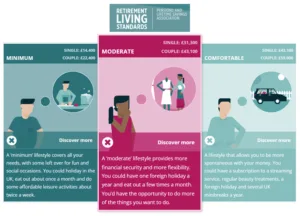31 Mar 2025
Thinking: How much is Enough?
Paul D Armson in his easily readable book on financial planning, “Enough”, explores the difficult question many of us face: how much money is enough? For some, the challenge is ensuring that they save a sufficient amount to cover their needs throughout retirement. For others, the real adaptation comes in a mental shift from saving to spending, because living a full life and dying with too much left is a waste of potential enjoyment of your time on earth (and can involve a larger-than-intended gift to the taxman to be spent by whichever government is in power at the time). Then there are also those for whom the calculations come in two parts: how much is enough for themselves, and what might they be able to give with warm hands – experiencing the satisfaction of seeing a real difference made in the lives of others (children, grandchildren, charitable causes, local community projects or legacies, etc.)
“Enough” identifies a few classic case studies:
- Mr and Mrs Ten Years Younger (a couple aged prematurely by the demands of their business, who are desperately holding on for ‘some day’ when they could live the life they want – as soon as they get there they start to look 10 years younger);
- Mr and Mrs Are We There Yet (knowing they wanted to retire, but not able to pinpoint whether they could afford to do so);
- Mr and Mrs Do It Yourself (with a motley collection of investments in pensions, ISAs, and other account types, picked up over years of bits and bobs with different investment advisers, articles online, tips from the Telegraph, etc. – for whom there was considerable stress and even anxiety in being buffeted by different opinions and lots of uncertainty about their investment and financial decisions)
In all of these and other cases, the biggest value-add from holistic financial planning was in building a clear overview of their situation, and being able to model their future including inflation, investment growth, taxation, lifestyle changes over time, and the relief they experienced from achieving far greater clarity going forward.
These days, what does enough start to look like? The Retirement Living Standards study shows that a “moderate” retirement lifestyle in the UK now costs £31,300 per year for a single person and £43,100 for a couple. With the full state pension from April 2025 set at £11,973 per year, if both spouses are fully entitled to the State Pension (and nothing changes in the future regarding eligibility for this – it’s not an amount guaranteed by the state) then just shy of £24,000 of income per year will be received from this. For a couple wanting a further £19,154 after tax, their pre-tax income per year at 20% tax rate will need to be £23,942.50.
A rough rule of thumb might be that a prudent retirement investment should set aside at least 25x the gross income required. In this case, the couple living a moderate lifestyle would require just shy of £600,000 to sustain their retirement income over time. A proper cashflow plan will look in far more granular detail at what total investments will be required to fund this lifestyle, and how different types of investment (pension, ISA, general investments) might be utilised to optimise the tax outcomes – potentially reducing the total amount required to fund retirement where some of the income may be taken tax-free. There is often significant nuance depending on each spouse’s income tax situation, investment risk appetite, health and projected longevity, as well as intended spending patterns in retirement.

All of the above is based on a “moderate” lifestyle which some might consider quite frugal (see above), and it is worth noting that the Retirement Living Standards Study gives a description of a more “comfortable” retirement that some high-earners today might still feel is not that generous – but the suggested cost for a couple is £59,000 per year (more in the London region). If you run the same calculations as above, the suggested capital required to fund this retirement is therefore in excess of £1m.
When it comes to having enough, the tax relief realised in pension contributions, and the compounding of growth over time are both the investor’s friend. The earlier you start to plan and save ahead, the more manageable you can make the journey to clarity and comfort regarding the future.
If you would like to discuss planning ahead for your retirement – please book a free initial chat with me:
https://calendly.com/duncan-bw-hoebridgewealth/30min
For more insight like this, please sign up for our newsletter here, you can unsubscribe at any time.
NOTE: Investments can go down as well as up in value, and you may get back less than your original investment. A pension is a long-term investment not normally accessible until 55 (57 from April 2028). None of the above is financial or investment advice and you should speak to me or someone else professionally qualified to give you advice specifically tailored to your circumstances.


 Production
Production